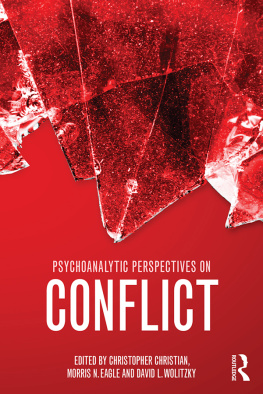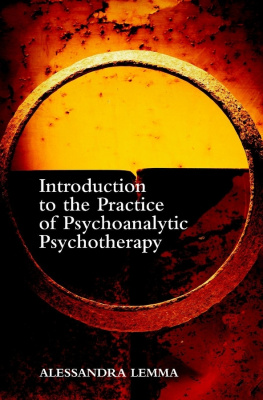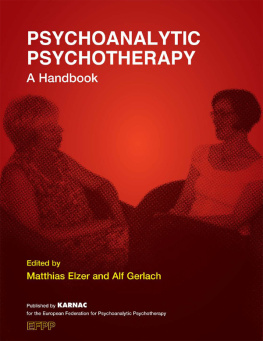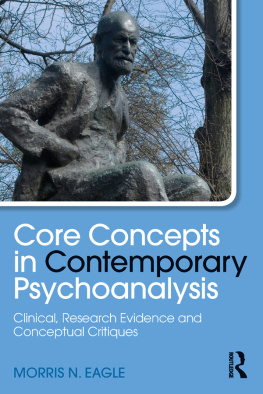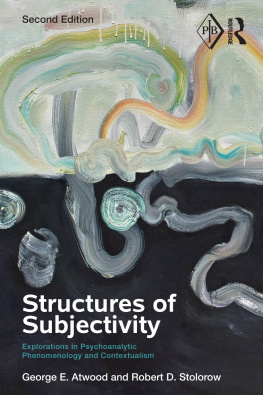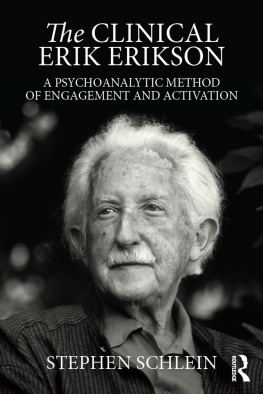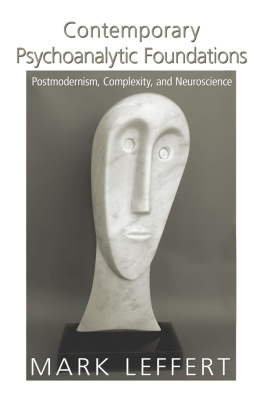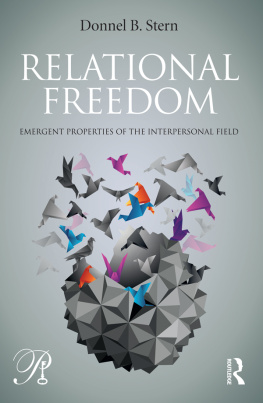THE INTERPERSONAL
TRADITION
The origins of psychoanalytic
subjectivity
Irwin Hirsch
First published 2015
by Routledge
27 Church Road, Hove, East Sussex, BN3 2FA
and by Routledge
711 Third Avenue, New York, NY 10017
Routledge is an imprint of the Taylor & Francis Group, an informa business
2015 Irwin Hirsch
The right of Irwin Hirsch to be identified as author of this work has been asserted by him in accordance with sections 77 and 78 of the Copyright, Designs and Patents Act 1988.
All rights reserved. No part of this book may be reprinted or reproduced or utilized in any form or by any electronic, mechanical, or other means, now known or hereafter invented, including photocopying and recording, or in any information storage or retrieval system, without permission in writing from the publishers.
Trademark notice: Product or corporate names may be trademarks or registered trademarks, and are used only for identification and explanation without intent to infringe.
British Library Cataloguing in Publication Data
A catalogue record for this book is available from the British Library
Library of Congress Cataloging in Publication Data
Hirsch, Irwin.
The interpersonal tradition : the origins of psychoanalytic subjectivity /
Irwin Hirsch. First Edition.
pages cm. (Psychoanalysis in a new key book series)
1. Psychoanalysis. I. Title.
BF173.H57 2014
150.19509dc23
2014015475
ISBN: 9780-415749510 (hbk)
ISBN: 9780-415749527 (pbk)
ISBN: 9781-315749273 (ebk)
Typeset in Bembo
by Wearset Ltd, Boldon, Tyne and Wear
CONTENTS
The Interpersonal Tradition: the Origins of
Psychoanalytic Subjectivity
Prominent leading psychoanalytic thinkers once associated with the classical Freudian hegemony of the American Psychoanalytic Association (e.g., Gabbard, 1995; Wallerstein, 1995), shortly prior to entering the twenty-first century, write of an emerging common ground with respect to theories of therapeutic action. This common ground crosses the boundaries of theoretical traditions that once were in considerable opposition to one another in this dimension. Both Gabbard and Wallerstein refer to the profoundly increased attention across much of the spectrum of the psychoanalytic literature to the concept of countertransference in particular, and more generally to the emphasis on the interacting and mutually influencing psyches of both participants in the psychoanalytic dyad. Once upon a time the mind of the specimen patient only was the object of study, and the analyst, conceptualized as a scientist, who when sufficiently analyzed himself was able to view the other with a pristine objectivity. Though this latter view may persist today among a minority of orthodox Freudian, Lacanian and Kleinian analysts, it endured surprisingly long after alternate visions of analytic subjectivity were introduced, initially by Ferenczi and Rank (1924), and then more systematically elaborated by Sullivan, Fromm and Thompson in the 1940s and 1950s, into what became the Interpersonal school or tradition.
This originally Interpersonal conception of the analyst as a co-participant (albeit in an asymmetrical relational matrix) in a relationship between two subjectivities has in recent years been supported by a new dimension of infant research. Enhanced by contemporary technology, researchers like Stern (1985) and Beebe (2000) have been able to capture on film the micro-interactions between mothers and infants, documenting the degree to which, from the earliest moments in life, the two parties invariably both engage and profoundly exert influence over one another. This provides a ready extrapolation to the psychoanalytic situation, that is, no two people can be together without having impact on one another. Were the technology employed by infant observation researchers applied to patient-therapist interaction it would no doubt be demonstrated that even the most subtle vocal and non-verbal actions between the two co-participants exert considerable reciprocal influence. It has become difficult to still argue that the psychoanalytic process is in any way a study of a subjective participant, the patient, through the eyes of a scientifically objective and non-participating or influencing psychoanalyst. Early Interpersonal writing, initially presented as an alternative to developmental theories emphasizing the primacy of endogenous drive states and defenses against these drives, served as a corrective to a psychoanalysis that did not fully recognize exogenous experience the unique significance of each subtle interaction between infant and caregiver from the moment of birth (or, perhaps, intrauterine) and through the entire life cycle. Indeed, a purely interactional theory of human development, so effectively documented by this generation of infant research, has reinforced the early Interpersonal emphasis on the mutually constructed configurations in the dyadic psychoanalytic situation, or for that matter, in any dyadic interaction.
The concept of analyst as objective observer has evolved to analyst as subjective, participant-observer, to analyst as observing-participant, and more recently, to analyst as mutual enactor (Hirsch, 1996). Each step in this evolution, initiated by early Interpersonal thinkers, places increased stress on analysts subjective and idiosyncratic presence. The changing conception of the analyst, and of the reciprocal nature of any analytic encounter, indeed, reflects the developmental perspective that parent-child dyads, like analysts and patients, have mutual impact in every moment of interaction. Analysts attention to countertransference now parallels attention to transference the two are considered part of what Mitchell (1988) referred to as an inseparable matrix. The analyst can no longer purport to be an even relatively objective observer of patients inner and outer worlds, nor free of an inevitable unwitting influence on the patient. As both Hoffman (1983) and Aron (1996) have illuminated, patients must be respected as capable observers of their analysts experience, just as analysts were always thought to be sensitive observers of their patients. That the contemporary psychoanalyst must now attempt to be aware of more than the patient per se, that attention to the psyche of the analyst and to the mutual influences in treatment now carry equivalent weight, is due in largest part to the early and ongoing Interpersonal contributions to our literature. This literature, first introduced over 65 years ago, more than that of any other psychoanalytic tradition, has ushered in what has been called the Relational or the postmodern turn in our field. This Interpersonal influence, as both Gabbard and Wallerstein have implied, has become woven into the fabric of a wide range of contemporary schools of thought or psychoanalytic identifications.
It is worth noting that though Sullivans (e.g., 1940) introduction of the term participant-observer signaled the beginning of the end of the one-person psychology illusion of objective observation in psychoanalysis, he and his colleagues contributions to the mutually subjective nature of contemporary psychoanalytic interaction are often not given their due. For example, terms like intersubjectivity, as elaborated most thoroughly by Stolorow (e.g., Stolorow and Atwood,
Analysts associated with this Interpersonal perspective originally viewed themselves in opposition to the hegemonic Freudians in the United States and did little to try to become integrated into the broader American or international psychoanalysis of the middle part of the twentieth century. There seemed to be a certain pleasure in being considered as rebellious and radical outsiders, reading the literature of the conservative majority, if at all, with a highly critical eye. Interpersonal teaching and writing was focused initially in the Washington, DC area, where it began with Sullivan, then largely in migration to New York City. The William Alanson White Institute was its primary home, though the Interpersonal voice also became very strongly represented at the NYU Postdoctoral Program, founded by White Institute graduates, to some extent at Adelphi Universitys Postdoctoral Program, and later at The Manhattan Institute for Psychoanalysis. Until the mid 1980s, when the Interpersonal perspective was reintroduced to the broader psychoanalytic audience, especially by Greenberg and Mitchell (1983), with the exception of the too often marginalized voice of Searles (e.g., 1965, 1979), and then reflected in Gills (e.g., 1982, 1983) theoretical shift, this was it. Up to this point the Inter-personalists published their own journal,


